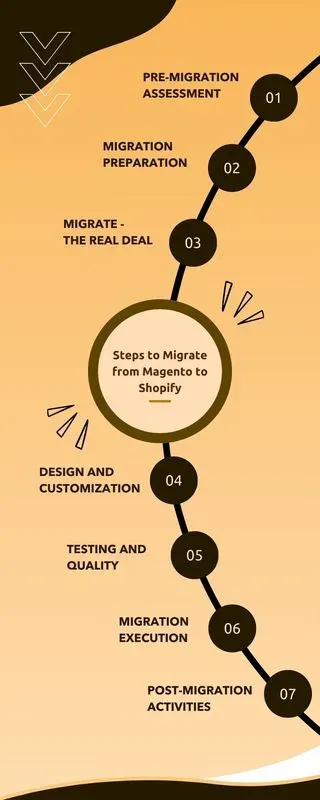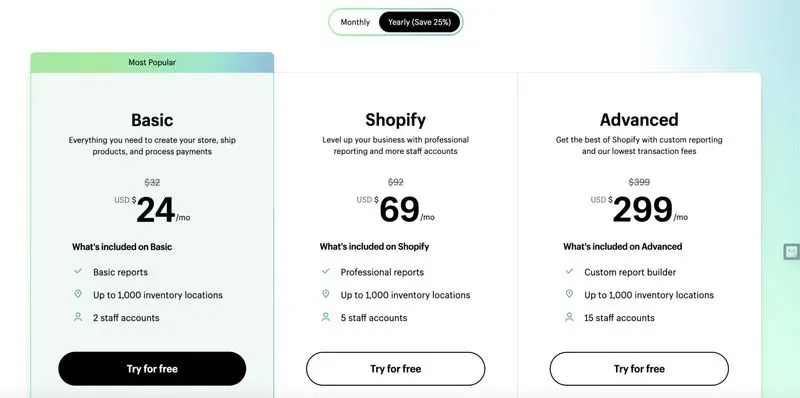Seamless Magento to Shopify Migration Guide!
By Pooja Uniyal on

Businesses aiming Magento to Shopify migration to futher scale their operations more easily and securely while avoiding the high costs associated with customization.
This shift is not unusual; numerous brands have transitioned from Magento to Shopify with remarkable success. For instance, Essential Jewellery, an e-commerce store, made the move and subsequently reported a 32% increase in its revenue.
Such transitions suggest that moving to Shopify might be a strategic decision. This blog aims to explain the necessity of the switch and offers guidance on Magento to Shopify migration in the most efficient manner, enabling businesses to resume sales swiftly.
Why Migrate from Magento to Shopify?
Magento is recognized widely as a potent platform for e-commerce websites, but it’s not without its drawbacks.
First off, Magento’s complexity is often seen as a hurdle, especially for those not well-versed in web development. Opting for this platform can lead to additional expenses for hiring developers or for training, alongside hosting and licensing fees, potentially eroding profit margins.
Moreover, while offering a wide array of 500 extensions, this abundance can paradoxically lead to decision-making difficulties due to the paradox of choice, while also introducing security vulnerabilities—a concern not as prevalent on alternative platforms like Shopify.
Shopify, in contrast, prides itself on a meticulously selected assortment of extensions, ensuring each one is thoroughly vetted for reliability. This platform’s user-friendly nature significantly reduces the learning curve, eliminating the need for extensive developer involvement.
Furthermore, Shopify’s dependable support network stands as a testament to its commitment to user satisfaction, as illustrated through various testimonials and reviews.
A closer examination of the comparative advantages of Shopify over Magento further highlights the benefits of opting for Shopify, delineating a pathway towards a smoother, more secure, and user-friendly experience for business owners.
The plan for Magento to Shopify migration is a strategic move for businesses aiming for streamlined operations and enhanced security.
Comprehensive Strategy to Migrate from Magento to Shopify
The process of transitioning from Magento to Shopify might present some challenges. Following the outlined steps will help navigate through the complexities of migration, ensuring a smooth transition.

Step 1: Pre-Migration Assessment
In this initial step, the groundwork for a seamless migration from Magento to Shopify should be established.
1. Assessing The Current Magento Store:
Comprehensive research on products must be conducted. Customer data is analyzed, order history reviewed, and existing content examined to fully understand the unique aspects of the Magento store - such as custom functionalities, content structure, or specialized SEO strategies - that could be beneficially carried over to the Shopify store.
Moreover, the performance metrics of the current store are studied. Traffic data is analyzed to identify patterns and understand visitor behavior, ensuring a thorough preparation for migration.
2. Setting Migration Goals:
Understand and define your brand’s objectives before the migration from Magento to Shopify. Whether the aim is a more streamlined user experience, improved site performance, or enhanced scalability is clarified.
Performance metrics like faster page load times, improved conversion rates, or increased customer engagement are established; these goals serve as benchmarks to gauge the site’s success after the migration.
3. Selecting the Right Shopify Plan:
Available plans on Shopify should now be compared, taking into account factors such as product range, anticipated traffic, and the level of customization required by the business. The aim is to select a scalable Shopify plan that accommodates future growth.


Step 2: Migration Preparation
The process encompasses two essential steps:
1. Backing Up Data:
Before the transition from Magento to Shopify, it is critical to protect the existing Magento data and content. This protection should cover blogs, webpages, order history, gift cards, products, and customer information.
Additionally, this stage presents an excellent opportunity to remove any underperforming content to foster a fresh appearance and ambiance for the new Shopify store.
2. Creating a Shopify Store:
Setting up a Shopify account is uncomplicated. It is advisable to spend some time familiarizing oneself with the dashboard, investigating product listing possibilities, and getting to know the order management features. Subsequently, one needs to fill in their details, explore the admin settings, personalize their store, and then the setup is complete.
Step 3: Migrate - the Real Deal
Data migration in Magento to Shopify migration is a critical step for businesses looking to transition their online stores to a new platform.
There are several methods to undertake this process, including simple copy-pasting of content onto Shopify, importing data via a CSV file, or employing a Shopify partner for a hassle-free migration. Specialized tools and services are also available to ensure efficient data transfer, preserving the integrity of business records throughout the migration process.
For those considering a Magento to Shopify migration, Matrixify is recommended as an exceptional import-export software. It allows for the comprehensive upload of various store fields, including products, customer data, and more, offering flexibility in updating fields without the need for a full re-import. The steps for using Matrixify are straightforward, from exporting data from the original platform to importing it into Shopify with a tailored Matrixify template.
The pricing for Matrixify varies, starting with a free demo and ranging up to an Enterprise package at $200 for 30 days.
Litextension is another tool that facilitates the migration process from Magento to Shopify without the need to halt store operations. It supports data transfer from a variety of formats and enables the migration of essential ecommerce components. The procedure involves selecting the source and target carts, setting up the migration, and running the process, which continues even if the browser is shut down. Pricing for Litextension depends on the volume of products, customers, orders, and blogs involved.
In addition to data migration, app and extension migration is a vital step. It involves evaluating current Magento extensions, identifying their Shopify-compatible counterparts, and possibly engaging in custom development for unique business needs. For instance, Postship is suggested for order tracking migration, demonstrating the approach to finding functional alternatives or solutions.
Lastly, maintaining SEO and URL integrity is paramount during migration. This involves identifying all Magento URLs, ensuring the Shopify store is operational, setting up 301 redirects, and updating metadata to preserve search engine rankings and provide a consistent user experience. This meticulous approach ensures a seamless transition for both the business and its customers.
Step 4: Design and Customization
The journey to making a store stand out involves tapping into the creative aspects of migration. Here is a simplified guide:S
1. Select a theme and customize the store:
The first step involves diving into the Shopify Themes Store to locate a theme that not only suits the business scale but also echoes the unique brand identity. Following the selection, the store can be personalized with specific colors, fonts, and layout adjustments.
2. Front-End Customizations
It’s crucial that the aesthetic and functional elements of the new Shopify store mirror those of the former Magento store to ensure a familiar environment for devoted customers. This includes keeping the navigation intuitive, product displays engaging, and overall user experience seamless.
3. Third-Party App Integration
The next step in the Magento to Shopify migration process requires visiting the Shopify App Store to find applications that could replicate or improve upon the features previously available on Magento.
Whether it’s an advanced review system or a beloved customer feature, the aim is to find apps that fit these needs perfectly. After selecting the appropriate apps, they should be integrated and tested within the Shopify store to guarantee smooth interoperability.
Step 5. Testing and Quality Assurance:
Ensuring that a new Shopify store operates flawlessly is crucial for its success.
Platform Testing:
- Testing involves clicking buttons, filling out forms, and adding products to the cart to verify functionality.
- The responsiveness of the store on mobile devices is also assessed to ensure a seamless shopping experience.
- Different customers have preferences for various browsers like Chrome or Safari. Hence, it’s important to test the store across multiple browsers to ensure a uniform experience for all users.
- Completing the checkout process and experimenting with different payment methods is essential to confirm that transactions are processed smoothly.
Domain Testing:
- Verifying that the domain correctly points to the Shopify store is a critical initial step.
- The configuration of the SSL certificate must be checked to ensure the store’s security is intact.
- Testing is recommended for order confirmations, shipping notifications, and other emails to ensure they reach the intended recipients and maintain professionalism.
- All internal and external links should be examined to facilitate smooth navigation for visitors within the store and to external sites.
- The store’s load times are crucial; statistics suggest that a significant percentage of customers are less inclined to return to a website that they find slow.
Step 6. Migration Execution (Launch time)
The process of transitioning to Shopify is designed to be seamless and impactful.
1. Launch Plan:
The initial step involves preparing customers for the migration from Magento to Shopify. This includes notifying them via emails, social media updates, and potentially incorporating a countdown feature on the Magento store.
Choosing the optimal time for the launch is crucial. It’s recommended to select a period when the target audience is most active. Ensuring that a recent backup of the Shopify store is available is also important. Introduction of changes should be done gradually.
This approach not only minimizes system overload but also provides an opportunity to identify and rectify any potential issues early on.
2. Monitoring and Performance Optimization:
Given that the store is in its initial stages after the Magento to Shopify migration, constant vigilance over performance metrics is essential. This encompasses monitoring load speed, SEO standings, and the general well-being of the store.
Additionally, verifying the flawless functioning of the SSL certificate is vital. Shopify’s analytics tools offer valuable insights for monitoring the store’s performance and preemptively addressing any issues to enhance the user experience.
Step 7. Post-Migration Activities
After the Magento to Shopify migration, and launching a new Shopify store, it’s crucial to follow the below-mentioned steps to ensure success.
1. User and Staff Training:
It’s vital for all team members to be proficient with the platform. Holding training sessions can help staff understand Shopify’s functionalities, including navigating the admin interface, processing orders, and managing customer details. Providing user guides or cheat sheets can aid in retaining new information.
2. Inventory Management:
Developing strategies for effective inventory synchronization and management on Shopify is essential. Shopify offers various features for monitoring stock levels, managing product variations, and updating product details.
Utilizing tools or apps that enhance Shopify’s inherent capabilities can keep inventory consistently accurate.
3. Legal and Compliance Considerations:
Ensuring the store’s compliance with data protection and privacy laws is imperative. Utilizing Shopify’s built-in data protection features, such as secure checkout and data encryption, helps achieve this.
Additionally, updating privacy policies and terms of service to meet Shopify’s standards and legal requirements is critical for both protecting the operation and establishing trust with customers.
Additional Considerations After Setting Up A New Shopify Store
As one settles into their new Shopify store, addressing a few additional points can help maintain the store’s prosperity.
1. Handling Multi-Language and Multi-Currency Features
For businesses serving international customers, incorporating multi-language and multi-currency functionalities is beneficial. Shopify supports selling in 20 languages and more than 50 currencies.
2. Custom Functionality and Scripts Migration
Evaluating and migrating custom scripts and functionalities vital to business operations is crucial. Collaborating with seasoned developers can ensure these unique features are integrated into the Shopify store successfully.
3. Downtime Management:
All e-commerce endeavors occasionally face downtime. To minimize its impact, Magento to Shopify migrations can be scheduled during periods of low traffic, utilize temporary landing pages to inform customers, and have a communication plan ready for any unforeseen issues.
Magento to Shopify Migration Success Stories
Several e-commerce companies have experienced significant growth in sales after migrating from Magento to Shopify.
1. Character.com
Character.com, an online retailer known for its wide range of character-themed clothing for both kids and adults, underwent a significant transformation. The company elected to revamp and migrate its online platform to Shopify, addressing several critical challenges along the way.
Initially, the website was plagued by an outdated design and numerous user experience (UX) issues. Through comprehensive user research, it was determined that adopting a mobile-first strategy and implementing a vibrant yet simplistic design would be most beneficial.
Additionally, the platform’s previous base, Magento, presented several operational hurdles, including management complexities and elevated server costs. To tackle this, a custom import script was developed, facilitating a seamless transition of data from the Magento system to Shopify.
The Magento to Shopify migration process was meticulously managed to ensure uninterrupted service. Character.com maintained the Magento site on a local server during the transition and utilized both Magento and Shopify APIs to accurately transfer product information, allowing for continuous product additions up until the launch.
The overhaul of Character.com’s online presence yielded impressive results. The site experienced a 40% surge in overall conversions, with mobile conversions rising by 65% and desktop conversions by 40%. Furthermore, the site’s bounce rate fell by 10%, indicating improved engagement.
Other notable outcomes included a 17% increase in the average order value, a 33% rise in pages viewed per session, and a staggering 300% growth in revenue compared to the prior year.
Migrate Faster Than the Great Snipes
Migration between Magento and Shopify doesn’t need to take an excessive amount of time or pose significant challenges. By adhering to the outlined steps, a new Shopify store can be set up swiftly. Here’s a summary of those steps:
- Pre-migration assessment: This involves evaluating the current Magento store, establishing migration objectives, and choosing the most suitable Shopify plan.
- Prepare for Migration: It’s important to safeguard data by backing it up and then proceeding to create a Shopify store.
- Migrate: During this phase, the transfer of data, applications, and extensions takes place. It’s also crucial to address SEO and URL preservation.
- Customize your store: This step allows for the selection of a theme, customization of the storefront, and the integration of third-party services.
- Test the quality: The platform and domain undergo thorough testing to ensure functionality and reliability.
- Launch the store: Choosing the optimum time for launch is vital, as is monitoring the store’s performance post-launch.
- Post-migration duties: Final steps include training staff on the new system, managing inventory effectively, and ensuring legal compliance.
Adhering to these procedures is essential for accomplishing a smooth Magento to Shopify migration.




